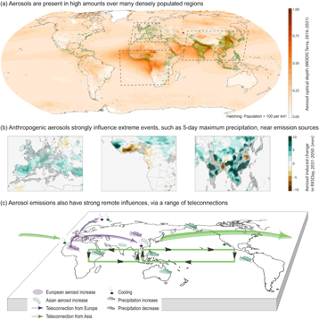Rapidly Evolving Aerosol Emissions are a Dangerous Omission from Near-Term Climate Risk Assessments
Anthropogenic aerosol (AA) emissions are expected to change rapidly over the coming decades, driven by a combination of industrialization, climate mitigation, and air quality efforts. These changes will drive strong, spatially complex trends in temperature, hydroclimate, and extreme events both near and far from emission sources. Unfortunately, standard framework evaluation of near-term climate risks (including the IPCC 6th Assessment Report) under-represent the temporal and geographical complexity of the AA emissions and responses, reducing them to a cooling partially masking the greenhouse gas warming. In this paper, the authors from the University of Texas at Austin, the CICERO Center for International Climate Research, the University of Reading, and other institutions demonstrate how AA-driven complex responses constitute a major missing element in society’s ability to prepare for future climate change and discuss ways forward.
Evolving aerosol emissions will be a major driver of climate change, and under-resourced, highly populated regions often bear the brunt of aerosols' climate and air quality effects, amplifying risk through heightened exposure and vulnerability. When policymakers turn to consultants, non-governmental organizations (NGOs), or even reports from the Intergovernmental Panel on Climate Change (IPCC) seeking assessments of climate-change risk, the impact of aerosols is often lost along the way. This paper is calling for better inclusion of rapidly evolving aerosol emissions in near-term climate risk assessments.
In this paper, the authors outline a pathway toward progress and call for greater interaction between aerosol research, impact modeling, scenario development, and risk assessment communities. Among others, pathways forward include an increase in scenario diversity in regional patterns and composition of aerosol emissions as part of CMIP7, greater intercomparison of assumptions driving aerosol emissions in future scenarios, or dedicated earth system modeling efforts, such as Regional Aerosol MIP (RAMIP).

